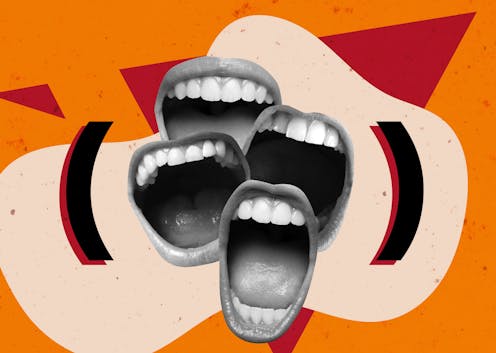Human exclamations of pain are similar across the world, new study reveals
- Written by Maïa Ponsonnet, Researcher, Linguistics, The University of Western Australia

We all know what words we might shout out when we stub a toe or touch something hot. For those of us who speak English, it’s probably “ouch”.
But what kinds of “pain words” (or “interjections”) do speakers of other languages use to express pain? And do these interjections feature similar sounds across languages, as we might expect if they are reflexive responses?
A new article published in the Journal of the Acoustical Society of America examines this question for the first time. Our study measured vowels (“a”, “i”, “o”, etc.) in interjections expressing pain, disgust and joy in over 130 languages across the globe. We then compared these with the vowels in nonlinguistic vocalisations (like moans, screams etc.) to test whether interjections and vocalisations share similar sounds.
Our results suggest pain interjections can indeed be traced back to nonlinguistic vocalisations, but the story is less clear for joy and disgust.
What are interjections?
Interjections are standalone words that can be used on their own (like “ouch!” or “wow!”). They don’t combine grammatically with other words.
Because linguists mostly study grammatical combinations, for a long time they didn’t pay much attention to interjections. This is why some very basic questions about them have yet to be answered – despite interjections being very frequent in speech and fundamental to communication.
Pain, disgust and joy
The main goal of our research was to find out whether interjections share similar vowels across languages based on the emotion or affect they’re meant to express.
If so, we wanted to know whether these commonalities can be explained by the acoustic forms of nonlinguistic vocalisations like cries and moans.
To test this, we collected pain, disgust and joy interjections from dictionaries spanning many languages in Africa, Asia, Australia and Europe (more than 500 interjections in 131 languages).
To compare our interjections with noninterjection words, we used large databases with comprehensive lists of words for languages in our sample. This allowed us to run statistical tests to compare the distribution of vowels in interjections to those found in other words.
These tests showed that on average, the pain interjections we collected have more “a” vowels, and more successions of vowels, like “ai” (as in “ay!” in Spanish) or “au” (as in “ouch!” in English). This applies across all the regions of the world we investigated.
To be clear, this result doesn’t mean all pain interjections will contain an “a”, “ai” or “au” sound. But if you pick a random pain interjection, it has more chances to have these sounds than if you pick a random disgust or joy interjection, or any other word.
Of the three types of affective experiences we looked at, pain was the only one with such properties. Vowels in disgust and joy interjections, by contrast, did not differ markedly from other words.
This shows the vowels in pain interjections are not random. So, where do they come from?
Pain interjections resemble pain vocalisations
To explore this question, we looked at the nonlinguistic sounds people make to express pain, as well as disgust and joy.
We recorded a large number of English, Japanese, Mandarin, Spanish and Turkish speakers producing vocal sounds – without conventional words – to express these affective experiences. We then counted the vowels in these vocalisations.
We found each emotional experience has its own vowel profile for vocalisations: pain has more “a” vowels, disgust more central, “neutral” vowels (like the second vowel in “dragon”), and joy has more “i” vowels.
In other words, both interjections and nonlinguistic vocalisations for pain have more “a” vowels than expected. However, disgust and joy interjections don’t share the same vowels as the vocalisations expressing those emotions.
What does it tell us?
Our study shows that while interjections are conventional and language-specific, their vowels are not fully random. Pain interjections have markedly more “a”, “ai” or “au” than expected. And with respect to “a”, they resemble nonlinguistic vocalisations.
This suggests that pain interjections could derive from the nonlinguistic sounds people produce when in pain, but this doesn’t seem to be the case for disgust and joy.
These results shed light on big questions about the origins of linguistic forms. We often think of words as arbitrary combinations of sounds. The fact people say “house” in English, but “casa” in Spanish, is often considered purely conventional.
But some aspects of language may be less arbitrary than others.
Pain – a central aspect of human experience – is associated with strong physiological and emotional responses, to the point that these spontaneous reactions could shape the conventional words humans use to express pain.
Much remains to be understood. In this study, we focused on vowels. But this raises the question: what about consonants (“p”, “t”, “s”, etc.)“? And what about emotions other than pain, disgust and joy?
Such investigations will shed further light on how embodied human language is, and how it developed originally in our ancestors.
Authors: Maïa Ponsonnet, Researcher, Linguistics, The University of Western Australia





